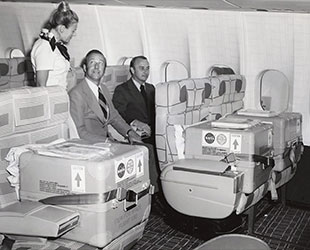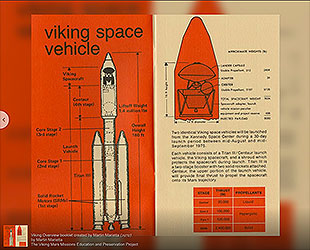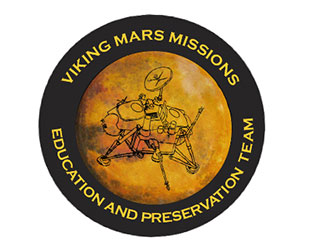January 26, 2016 — Almost 40 years before SpaceX and Blue Origin made history by landing rockets on the ground, a NASA probe fired three engines to descend through the atmosphere and touch down on the surface.
That landing however was not on the Earth. Rather, Viking 1 achieved the first successful landing on Mars on July 20, 1976, descending vertically and touching down on its legs, just as the commercial spaceflight companies did with their rockets four decades later.
Before Viking launched to the Red Planet, its engines were strapped into first class seats aboard a Continental Airlines jetliner and flown from Seattle to Denver, where they were installed on the spacecraft. The three engines, which were built in Redmond, forwent the airplane's cargo hold in favor of the passenger cabin due to security concerns.
"Why first class?" posed the Associated Press in an article published in 1974. "Because the 50-pound rocket engines packed in containers were too wide for coach-class seats."

First class trip for the Viking rocket engines from SeaTac airport to Martin Marietta in Colorado for assembly in 1974. (VMMEPP) |
That tidbit – preserved in the form of a newspaper clipping – is among the hundreds of digital resources that are now available to the public through the Viking Mission Museum, an online archive from the non-profit Viking Mars Missions Education & Preservation Project (VMMEPP). Established in 2013, the project collects and curates artifacts and team recollections from NASA's first journey to Mars' surface.
"Viking technology and methodology permeate aerospace missions, from the throttleable terminal descent engines of Blue Origin and SpaceX to camera systems on [the Mars rovers] Spirit and Opportunity," VMMEPP leaders stated in the introduction to the museum. "But, equally important are the peer influences that have continued to extend Viking's reach into the asteroid recovery [mission] OSIRIS REx, the Hubble Space Telescope and the educational and cultural fabric that guides future generations through teaching and the arts."
"Viking's influence can be seen everywhere," the project's leaders stated.

Viking Overview booklet, created by contractor Martin Marietta and presented in the Viking Mission Museum. (VMMEPP) |
And now, the sources of that influence can be seen online thanks to a partnership between VMMEPP and the Google Cultural Institute, a five-year-old initiative that presents and preserves photographs, videos and documents. The Viking Mission Museum, which was launched last Thursday (Jan. 21), displays an initial exhibition of more than 300 artifacts from the Viking orbiter and lander mission.
"For our organization, [the museum's] launch is significant, as it supports both of our key objectives with one singular event – to preserve the history of Viking and to inspire and educate future generations," Rachel Tillman, the executive director and founder of the preservation project, said. "Our resources are being utilized by students from elementary through graduate school, space professionals and writers who will continue the cultural influence that Viking began."
"Further," added Tillman, "it is personally important to us to honor the men and women of Viking, many of whom were never recognized for their roles. Viking brought conflicting interests and individuals together into a cohesive team and 'family' that changed the face and direction of exploration."
Among the objects on display in the virtual museum are a complete library of the Viking Mission Bulletins that guided the public and press through the preparation, launch and discoveries made by the mission; a previously unpublished detailed specification for Viking's meteorology instrument; a White House document required for the mission's use of plutonium; and a Lunar Orbiter document that helped the Langley Research Center in Virginia be chosen to host the Viking Project Office for NASA.

Viking Mars Missions Education & Preservation Project team logo |
In the coming months, VMMEPP intends to add materials covering the spacecraft's engineering details, the personal experiences of Viking team members and all of the images from the mission, including many that were not previously shared with the public.
"The online Viking Mission Museum will grow as we curate and develop the interview content into produced material," VMMEPP leaders stated. "Please enjoy this first high level overview and nuggets provided by the Vikings themselves, and produced by our organization."
